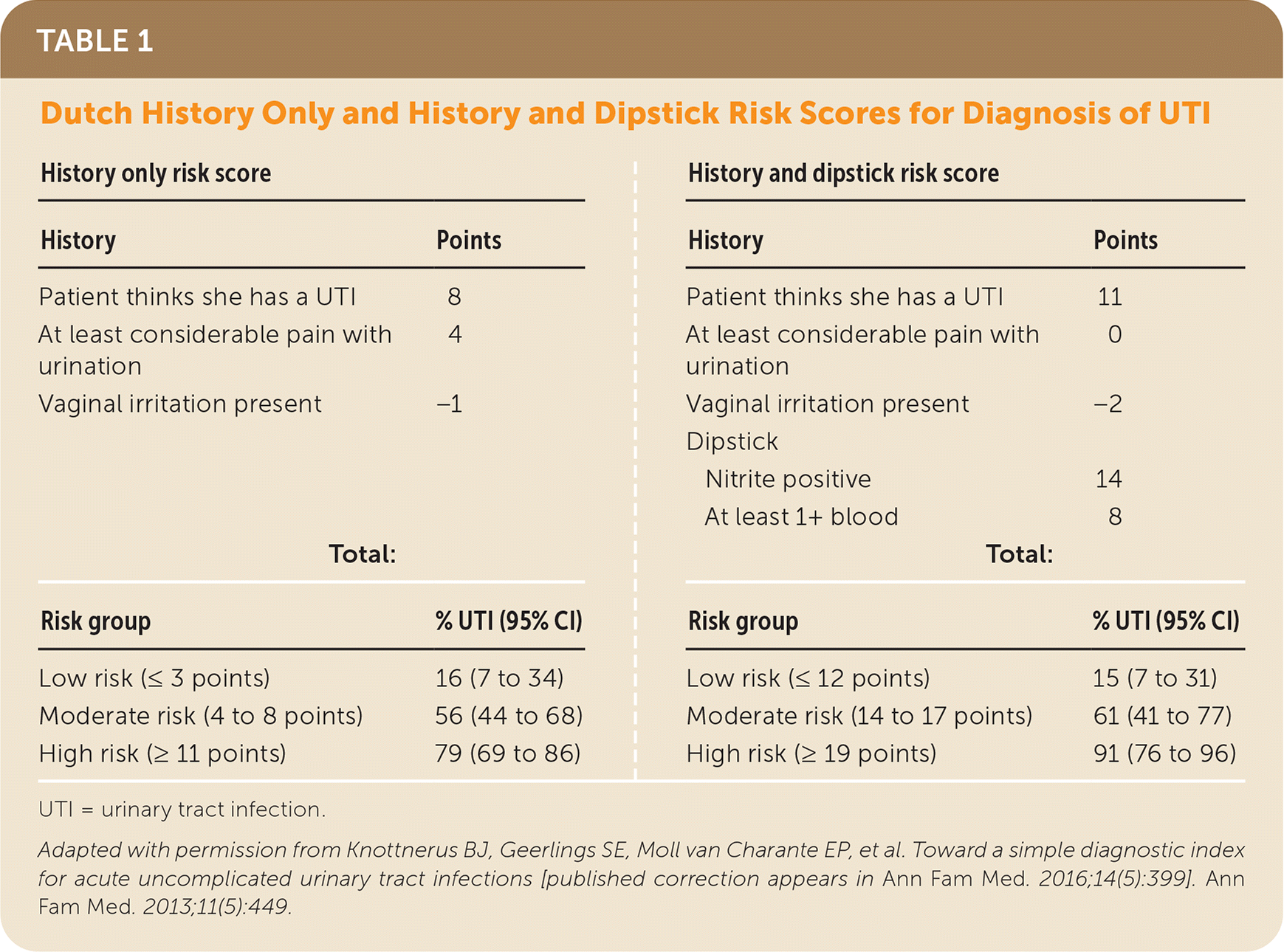
Am Fam Physician. 2022;106(3):335-336
Author disclosure: No relevant financial relationships.
Clinical Question
How can signs, symptoms, and urine dipstick testing best be used for the diagnosis of urinary tract infection (UTI) in women?
Evidence Summary
The prevalence of positive results from urine cultures among women presenting to a primary care physician with symptoms of UTI ranges from 25% to 88% in published studies, but it is usually more than 50%.1–6 Treatment based on history alone without testing urine is relatively common, especially in otherwise healthy women with a history of UTI. This practice may result in overuse of antibiotics.7
A systematic review and individual patient data meta-analysis investigated the effects of analgesics, herbal formulations, and delayed prescription of antibiotics in women with uncomplicated UTI compared with immediate antibiotic treatment strategies.8 Data showed an increased likelihood of incomplete recovery when using analgesics, herbal formulations, and delayed prescription strategies instead of immediate antibiotics (odds ratio = 3.0; 95% CI, 1.7 to 5.5), but a two-thirds reduction in the use of antibiotics. Erythrocytes and bacteria in the urine were the best predictors of which patients would benefit from antibiotics. Although rapid point-of-care tests have been developed to detect gram-negative bacteria in urine, they have not been widely adopted.9 Use of a clinical prediction rule or risk score integrating signs, symptoms, and urine findings could help guide the use of empiric antibiotics in women with a high likelihood of UTI, with urine culture and anti-inflammatory medications for those at lower risk.
Two risk scores were developed more than 30 years ago. One used retrospective chart data, which are less reliable than prospectively collected data.10 The other required seven symptoms, three elements of medical history, and dipstick testing, making it complex for application in a clinical setting.11 Therefore, there was a need for newer prediction rules that incorporate current microbiologic trends.
A group in the United Kingdom developed a clinical risk score for the diagnosis of UTI that was considered positive when two or more of the following were present: moderately severe dysuria or nocturia, offensive smelling or cloudy urine, and the presence of nitrites or leukocytes and blood in the urine.4 They also proposed a score based on dipstick results alone. However, the positive and negative predictive values of the risk scores were too low to be clinically helpful in a validation study.11
Another decision aid was developed and validated by a Canadian group. The three-item clinical decision aid criteria consist of the presence of dysuria and more than trace leukocytes and any nitrites in the urine. The prevalence of positive urine culture results for patients meeting zero to three criteria were 23%, 43%, 69%, and 89%, respectively. They recommended empiric antibiotics for patients with two or more criteria, and a urine culture to confirm infection for those with zero or one criterion.12 In an external validation study, accuracy was similar, with prevalence of positive urine culture results of 29%, 47%, 63%, and 77%.13
A Dutch group identified 196 women presenting to their primary care physician with painful or frequent urination; of those, 61% were diagnosed with UTI by urine culture.3 They developed and internally validated two simple risk scores, one using symptoms only and one using symptoms and dipstick results; the scores have not yet been externally validated. Both risk scores were able to classify women into low-, moderate-, and high-risk groups (Table 13). The cutoffs to define low- and high-risk groups (i.e., those who could be safely ruled out and ruled in) were based on a poll of Dutch family physicians, similar to the physicians expected to use this rule in their practices.

| History only risk score | History and dipstick risk score | ||
| History | Points | History | Points |
| Patient thinks she has a UTI | 8 | Patient thinks she has a UTI | 11 |
| At least considerable pain with urination | 4 | At least considerable pain with urination | 0 |
| Vaginal irritation present | −1 | Vaginal irritation present | −2 |
| Dipstick | |||
| Nitrite positive | 14 | ||
| At least 1+ blood | 8 | ||
| Total: | Total: | ||
| Risk group | % UTI (95% CI) | Risk group | % UTI (95% CI) |
| Low risk (≤ 3 points) | 16 (7 to 34) | Low risk (≤ 12 points) | 15 (7 to 31) |
| Moderate risk (4 to 8 points) | 56 (44 to 68) | Moderate risk (14 to 17 points) | 61 (41 to 77) |
| High risk (≥ 11 points) | 79 (69 to 86) | High risk (≥ 19 points) | 91 (76 to 96) |
Applying the Evidence
An otherwise healthy 35-year-old woman presents to your office and says that she thinks she may have a bladder infection because it burns when she urinates. She had a UTI at 20 years of age and reports that her current symptoms feel the same. She denies vaginal irritation and states that the pain is mild to moderate in severity. Based on her history, you assign 8 points using the Dutch history only risk score. You obtain a urinalysis and find that there is no evidence of blood, but nitrites are positive and she has 2+ leukocytes. Her history and dipstick risk score is 25 points. You diagnose UTI and discuss treatment options.
Editor's Note: Dr. Ebell is deputy editor for evidence-based medicine for AFP.
